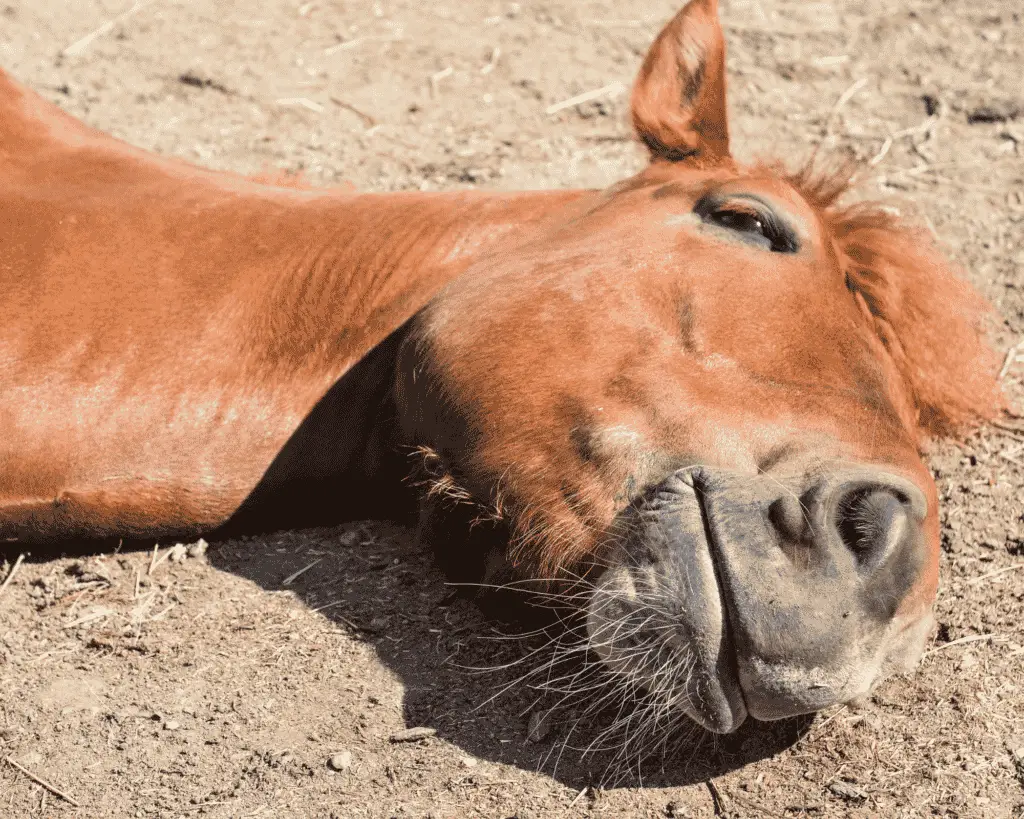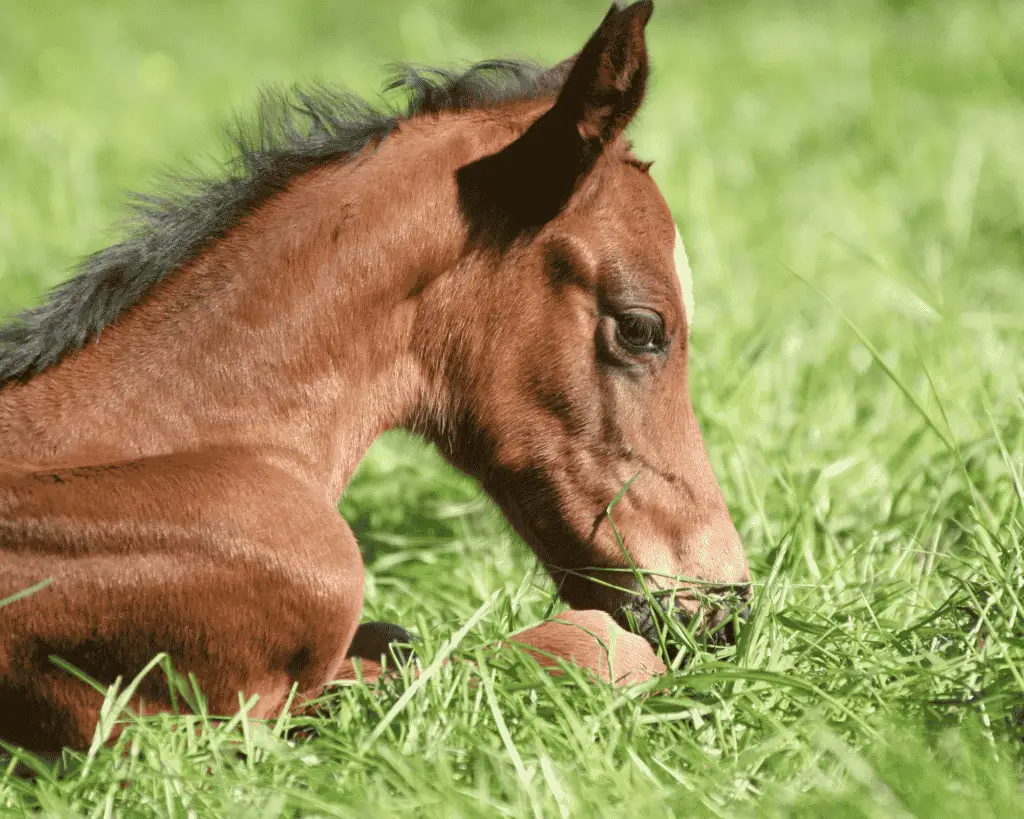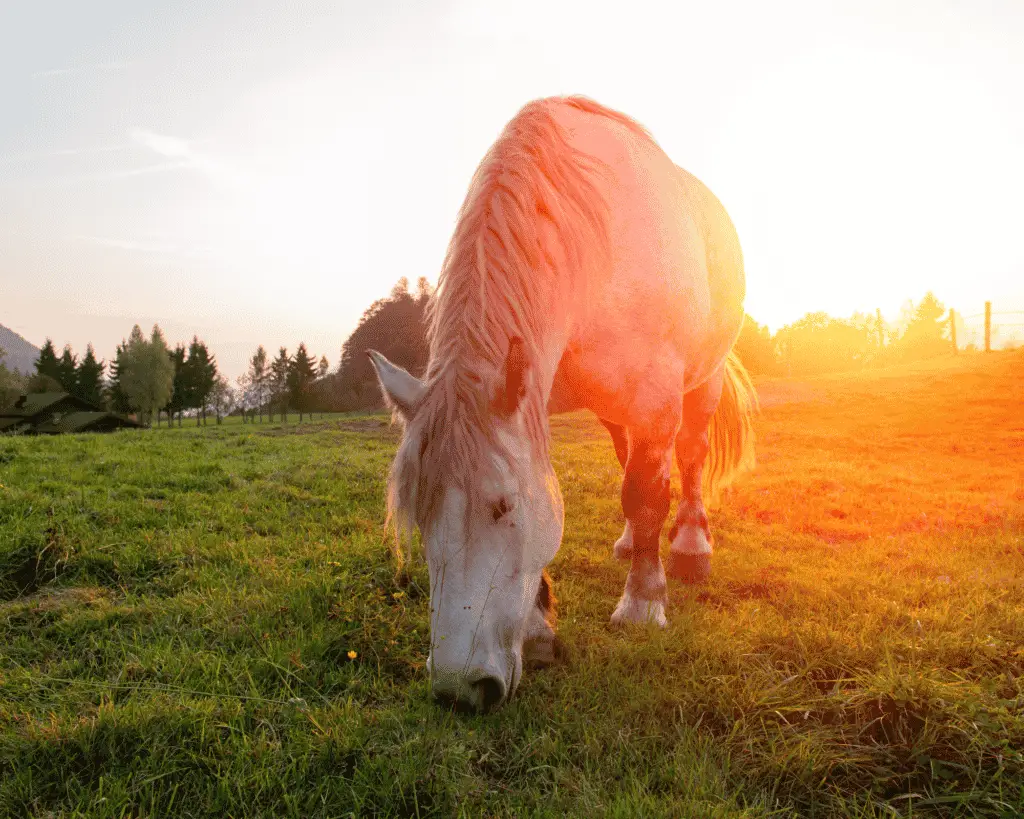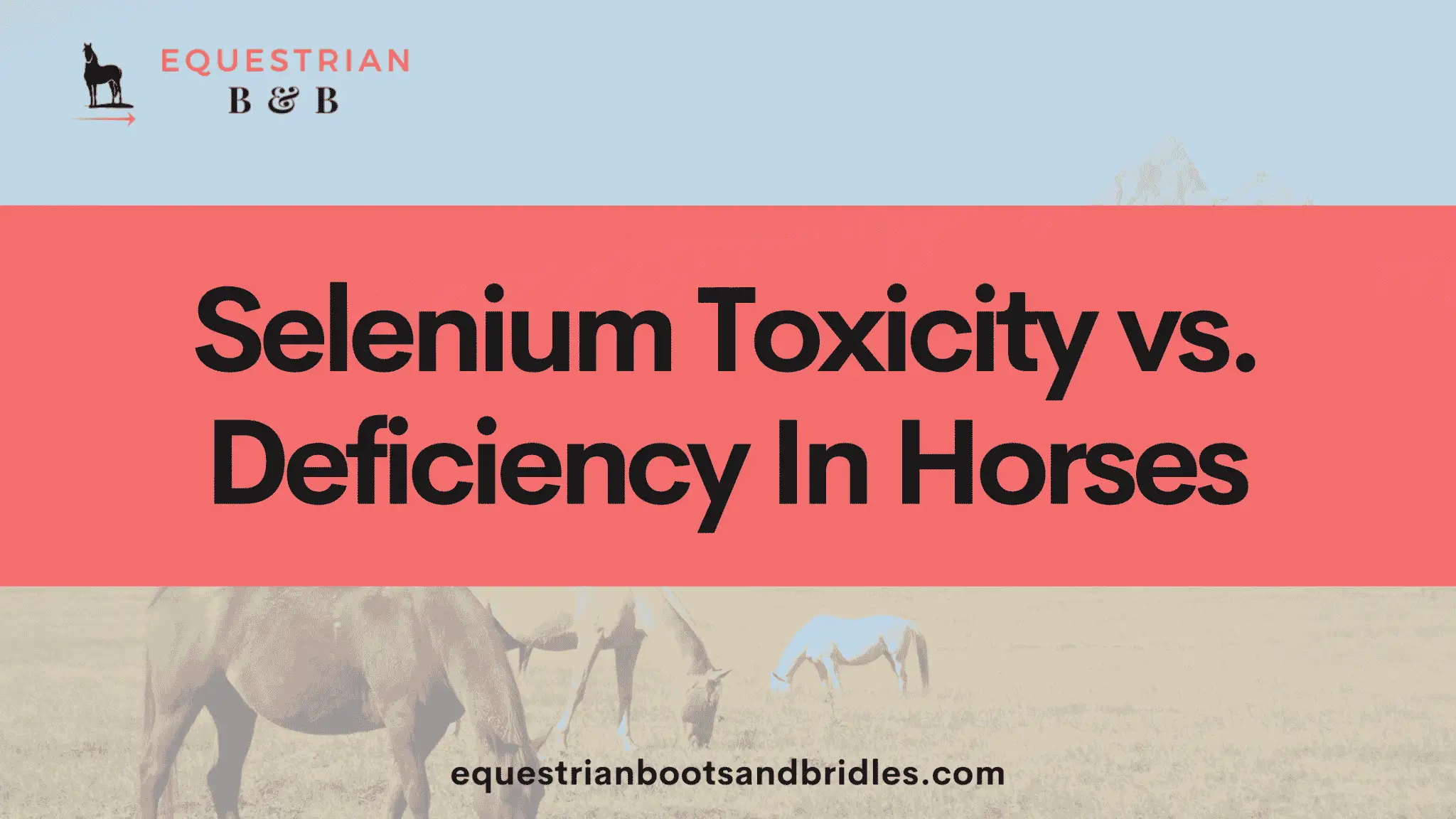Selenium is a vital nutrient that helps horses maintain their muscular system and deliver their best performance in the show ring. It’s a naturally occurring and essential trace mineral that’s required in very small amounts for optimal muscle performance, lowering oxidative stress, and aiding thyroid and immune functions.
The line between selenium toxicity in horses and deficiency is a fine one, with the maximum recommended daily amount consisting of 3mg for horses doing heavy work. Most horses require no more than 3 mg of selenium per day, a small amount in comparison to a horse’s overall size. However, some regions of the U.S. produce forage that’s deficient in selenium and vitamin E, making supplementing selenium a matter of course.
The fact that forage is deficient in selenium is not lost on manufacturers of hard feed. Horse food manufacturers include trace amounts of selenium in their products as a matter of course. It’s a good idea to check the levels of selenium in the hard feed you’re providing your horse to make sure they’re receiving the right amount on a daily basis.
Not all areas of the U.S. are deficient in selenium, though. States including Colorado and New Mexico feature plants that are high in selenium, and horses are likely to graze on them. A horse can obtain sufficient amounts of selenium in their diet from forage, and supplementation in these areas can lead to selenium toxicity in horses.
Ultimately, selenium is an essential component of a horse’s diet and aids in its ability to deliver peak performance and muscle power. Before you decide to supplement your horse’s diet, you’ll need to make a few informed decisions on how to go about it. This guide is designed to help you understand the difference between selenium deficiency and toxicity in horses and if it’s right for your horse.
And as always, be sure to check with your veterinarian before starting or stopping any special diets or supplementations for your horse.
The Importance of Selenium in a Horse’s Diet
Selenium is an antioxidant that prevents free radicals from damaging cell walls. When it’s present in sufficient amounts, your horse’s body functions as it should and enables it to deliver its best performance. A horse’s joints and muscles work their best when oxidative stress is kept to a minimum.
Many horses are selenium deficient and horse owners may never be aware of this fact. A horse that’s low in this vital antioxidant won’t necessarily show signs of deficiency due to the fact that vitamin E covers low selenium levels. Horses who are fed forage such as alfalfa and graze on green grass will consume adequate amounts of vitamin E and look healthy as a result.
A horse’s metabolic process, just as with any other mammal, engages in an oxidation process that breaks down proteins, carbohydrates, and fats into energy, water, and carbon dioxide. Oxidation helps supply the horse’s body with the components it needs to function at its best.
However, oxidation doesn’t discriminate when it comes to breaking down nutrients into a usable form. Instead, it causes oxidative damage in the form of free radicals and superoxides. These oxidizing agents, now known as peroxides, damage cell membranes among other cell structures. Selenium prevents oxidizing agents from forming or dealing with them after they’re formed.
Selenium is part of the enzyme called glutathione peroxidase. This enzyme destroys peroxides and turns them into alcohols. This conversion prevents them from damaging cell membranes that make cells susceptible to further injury and cell death.
The lack of discernment of the oxidative process results in the production of peroxides which can damage and kill cells that are vital for muscle function and other growth processes.

Oxidative Stress and Muscle Function
A horse’s muscular system consumes vast amounts of oxygen during exercise or competition. Oxygenation provides the muscles with the power they need to function at their best. However, oxygenation also causes free radicals and peroxides to form the same as the metabolic process. Once again, these agents damage cell walls, which makes it harder for a horse to recover from exertion.
The antioxidant properties of selenium protect muscle cells from becoming damaged by free radicals and make it easier for a horse to recover from exercise. The nutrient also helps the horse maintain its overall quality of life, but it also protects the heart, the most important muscle of them all.
Symptoms of Selenium Toxicity in Horses
The clinical signs of selenium toxicity, also known as alkali disease, can take months to become apparent. A horse that’s foraging on selenium-rich plants will accumulate more selenium than they need over a period of time, and the signs of toxicity may not be readily visible.
The trace mineral accumulates in the body of the horse because the excretory system can’t keep up with the intake. Over time, selenium toxicity in horses shows up as signs that include the following:
- Hair loss in mane and tail
- Abscesses in the coronary band
- Impaired movement
- Difficulty swallowing
- Respiratory distress
- Cracking of hoof wall
- Founder
- Impaired heart function
- Muscle inflammation
- Excess salivation
- Muscle tremors
- Blindness
- Collapse
A horse experiencing selenium toxicity looks anemic and weak, has a dull hair coat, and its mane and tail hair break off. Cartilage in the joints degrades and lameness becomes apparent. If efforts aren’t made to eliminate selenium from the horse’s diet, the horse will eventually die from respiratory failure.

Symptoms of Selenium Deficiency in Horses
The signs of selenium deficiency in horses are similar to toxicosis, but again, it takes time for the signs to show up in most horses. A horse that’s deficient will move as if it’s much older than its physical age for no visually discernable reason.
The signs of selenium deficiency in horses include:
- Stiff gaits
- Lack of inability to perform
- Muscle spasms
- Trembling
- Sore muscles
- Muscle wasting
- Difficulty standing up
- Respiratory distress
- Coughing while eating
You may find yourself concerned about the amount of selenium your horse is consuming to overcome a deficiency. The good news is that your horse can handle small amounts of excess selenium, and you won’t put them in danger if it’s fed a couple of extra milligrams.
Tying Up and Cribbing
Tying up, also known as equine rhabdomyolysis, is a type of muscle cramp that presents most prominently in the hindquarters and abdominal area of a horse. A horse that’s selenium deficient is more prone to experiencing an episode due to the fact the muscles are already compromised.
Cribbing has been linked to (but not definitively associated with) deficiency. A small study showed that cribbers were very low in selenium, but the link is not definitive. There was no follow-up that indicated the cribbers stopped their behavior after their selenium levels improved.
Signs of Selenium Deficiency in Foals
Foals get all of their nutrition from their dams in the early days of their lives. When a dam is suffering from selenium deficiency, she won’t pass enough of it to her foal. A foal will then develop a condition known as white muscle disease and fail to thrive. The signs of white muscle disease include:
- Poor suckle reflex
- Inability to rise
- Muscle weakness
- Difficulty swallowing
- Discolored urine
- Rapid heart rate
White muscle disease can be avoided by providing dams with selenium supplementation as part of their daily feed when they’re in foal and not.

How to Treat Selenium Toxicity and Deficiency
There is no treatment for selenium toxicity in horses, but it is easy to treat a deficiency. The only way to treat a case of selenium toxicosis is to remove all feedstuffs with selenium and hope that the horse’s excretory system can eliminate the excess.
Treatment for a deficiency begins with a veterinarian drawing blood for a blood panel that checks for levels of selenium in the blood serum. The results of the panel will show how much selenium is in the horse’s bloodstream and if it’s deficient or not.
In the event the horse is deficient, the veterinarian will advise you on how much is needed to make up for the lack of selenium, and which method of delivery is best. A horse that is severely deficient may receive treatment through intravenous, intramuscular, or oral supplementation. The delivery method that’s used is dependent on the level of deficiency.
Natural Sources of Selenium vs. Supplements
Large areas of the United States feature soils that are deficient in selenium. They include the Pacific Northwest, Northeast, Atlantic coastal area, Florida, and the areas surrounding the Great Lakes in the Midwest and upper Midwest. These areas are ideal for horsekeeping due to the abundance of inexpensive forage and large areas of land available for barns and stables.
Selenium originates from igneous rocks, which means the mountainous regions of the U.S. are more likely to have an abundance of the mineral. Plants draw up selenium from the soil and horses tend to graze on them, collecting sufficient amounts of the mineral as they graze.
However, there’s always an inherent risk that a horse will develop toxicosis from too much grazing on selenium-rich plants. On the other hand, a horse can be over-supplemented through regular feed as well, leading to the same problem.
When it comes to the quality of natural sources of selenium versus supplements, there is little to no difference. The high-quality supplemental variety is derived from a variety of sources and comes in multiple forms, including selenium yeast. A horse’s metabolic system doesn’t differentiate between natural and inorganic selenium. The metabolic system takes up the selenium and puts it to use regardless of its origin.
How Vitamin E Covers For Selenium Deficiency
Both vitamin E and selenium perform the same tasks as antioxidants. When a horse is deficient in vitamin E, selenium takes over, and vice-versa (provided there’s enough of one or the other in the forage). The presence of vitamin E in the cell membrane slows down the production of peroxides that damage the membrane, whereas the presence of selenium in intracellular fluid removes the peroxides.
Both of these nutrients balance each other out in terms of how they do their job. A deficiency in vitamin E results in the formation of more peroxides, resulting in a need for more selenium. Low selenium levels result in fewer peroxides being removed from the system and require more vitamin E to prevent the formation of peroxides.

FAQs About Selenium Deficiency and Toxicity in Horses
How can I find out if my area is deficient in selenium?
Your local agriculture extension office can tell you about the selenium levels in the soil found in your area. The agriculture extension office monitors the levels of nutrients in local soils and includes their findings in regular reports.
Another resource is your veterinarian. They’re most likely going to be familiar with the quality of nutrition that’s found in locally produced forage and can tell you if there’s an issue with selenium deficiency in horses. Your veterinarian can tell you with a strong degree of certainty as to the bioavailability of selenium and vitamin E in local forage.
How do I find out if my horse is selenium deficient or not?
The best way to find out is to have a blood panel drawn by your veterinarian and sent off to a lab for testing. The lab analyzes the blood for selenium content and assigns a value that tells the vet if the levels are too high, too low, or just right.
Should I test my horse regularly for selenium deficiency?
How frequently you get your horse tested depends on the kind of work your horse is doing. A horse that’s in regular training for performance at all levels should get regular checkups to monitor its physical condition. It’s not a bad idea to get your horse’s blood drawn to check selenium levels and optimize their supplementation.
What’s the best way to supplement selenium in my horse’s diet?
The best and easiest way to begin selenium supplementation is to include it in hard feed or purchase a hard feed that contains enough selenium to meet your horse’s daily needs and optimize its supplementation.

